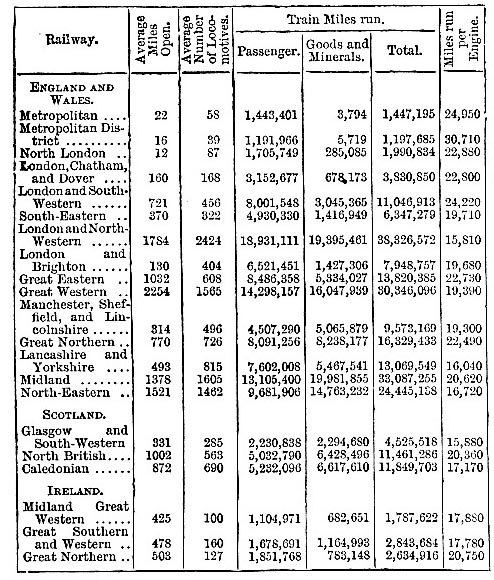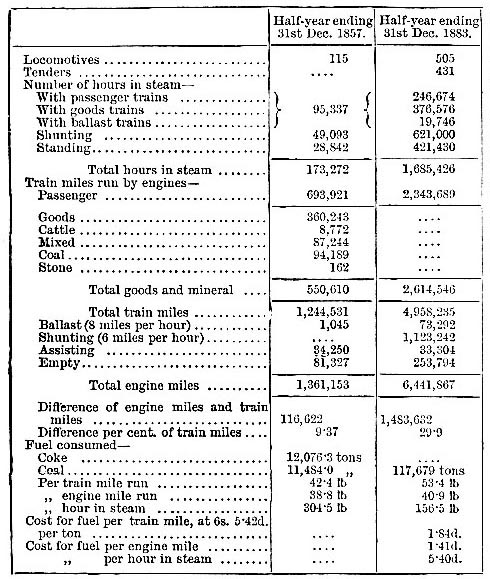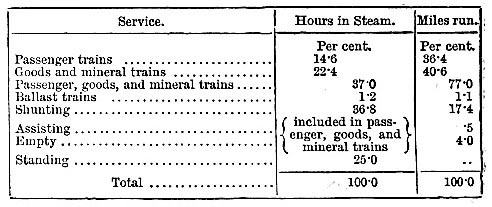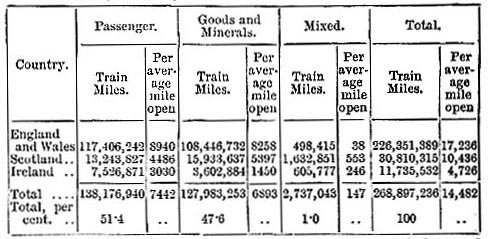1902 Encyclopedia > Railway, Railways (Railroad) > Train Miles Run, 1883
Railway, Railways
(Part 7)
B. RAILWAYS - STATISTICS (cont.)
Train Miles Run, 1883
The number of miles run by passenger and goods and mineral trains, and the number run by mixed trains, are as follows (table V.):—
The mixed-train miles constitute just 1 per cent. of the total number, and the mileages run by passenger and goods trains are nearly equal, on an average each mile of way was traversed forty times a day. Taking the means of the numbers of engines for the end of 1882 and the end of 1883 as the average number during the year, the train miles run per locomotive are as follows (Table VI.):—
An engine when actually on duty may accomplish 120 train miles per day, which would make upwards of 40,000 per annum. But at any moment half the engines may be taken as in reserve or under repair, which reduces the average performance per engine of the whole stock to some 20,000 miles per year, and the circumstances of many lines do not admit of such high averages of mileage run. Taking the twenty-one leading lines in detail, following the selection already made to show the quantities of working stock, the number of train miles run on the different lines in 1883 is shown in Table VII. as follows:—

TABLE VIII (below).—Duties performed by Engines of Manchester, Sheffield, and Lincolnshire Railway.

In general the lines of preponderating passenger-train miles run the greater number of miles per engine. The small mileage per engine of the London and North-Western line, with a relatively small goods-train mileage, is partly explained by the fact that this company had 141 duplicate locomotives in 1883. Engines run many miles unavoidably "empty,"—that is, without a train, the proportion of the empty or unprofitable mileage depending on the traffic and the nature of the line. A line with locally heavy gradients must have "assistant" or "pilot" engines in readiness to assist the trains up the inclines, and such engine usually have to return empty to the depot; and in cases of special trains empty engines are run to or from the train, as the case may happen. Engines, especially assistant engines, may have to stand "in steam" or with the steam up and the fire in good order, in readiness to act when required. Some railway companies register the whole time the engines are in steam, also the assistant, ballasting, and empty mileage run, besides the time on active duty and the train miles run. The nature of the duty of goods engines, which is various, is also distinguished, so as, in short, to make a complete record of the work done. Thus for the Manchester, Sheffield, and Lincolnshire Railway Table VIII. (see above) gives the duties performed by the engines during the second half-years of 1857 and 1883. The time of engines assisting and running empty are included in the hours in steam with trains,—passenger and goods respectively. There were about 170 engines employed in shunting and marshalling trains. The relative percentages of the hours the engines were in steam and of miles run on different duties in the second half-year of 1883 are given Table IX.:—

The proportion of extra engine mileage to the work done in hauling goods, minerals, and passengers varies very much on different systems, according to the nature of the traffic, for by far the greater part of it arises in connexion with goods and minerals, which itself is a very varying quantity. The train mile, therefore,—that is, the revenue-producing train mile—though it is the simplest and hardiest unit of performance, is not an absolute measure of work done. The shunting or marshalling of trains is an item not indicated by train mileage, and yet it is hard work and occupies as many hours in steam as the train mileage. Again, the fuel consumed, reckoned only on the train mileage run, amounts to 53 lb per mile run; but, reckoned on the total mileage run by engines, in which the extra mileage, whether ballasting, shunting, or assisting, is hard work, it amounts only to 41 lb per mile run.
On the London and North-Western Railway in 1874 the total shunting time was 613,472 hours of one engine—about the same as on the Sheffield line in 1883—and on this work 171 engines were constantly employed, marshalling and classifying the trains in the sidings. A like number, so employed on the Sheffield line, amount to one-third of the total locomotive stock.
Read the rest of this article:
Railway, Railways - Table of Contents
|




